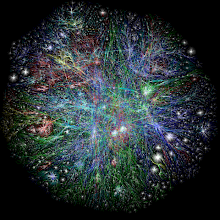Young people’s engagement with news media has come a long way from simply reading a newspaper or watching the news on television. Since the introduction of Web 2.0, news has become available in a variety of forms, including blogs and podcasts. However, contrasting to traditional forms of media, audiences are now able to not only absorb news in a one-way relationship, but comment on and respond to news, and even develop and compose their own news stories, forming a two-way relationship. Web 2.0 has transformed journalism into a practice that anyone can engage in, not just a profession. A university degree or employment with a media institution is no longer required – all that is needed is something as simple as a computer or a video phone.
One example of this is citizen journalism - media made by non-professional journalists, and can include things such as blogs (such as Investigative Blog and Online Journalism Blog), podcasts (such as The Pod Lounge) and the use of YouTube. Although there are many criticisms questioning whether or not citizen journalism is real journalism, I believe that it helps young people to engage with and develop a better understanding of the news and public information, especially journalism which recontextualises and reversions existing information. This is what Saunders refers to in his 2006 thesis, Citizen Media and Investigative Journalism as Hartley’s notion of redactive journalism - journalism that is made by editing, and makes sense of publicly available information. This may include anything from the cut-and-paste of bloggers to the remix news of political satire programs such as The Daily Show (Saunders 2006). Not only do the creators of redactive journalism engage with the news, but readers and those participating also engage with it, perhaps gaining a better understanding of the information than they would with a more conventional news source.
I believe that although it may not always be the most RELIABLE source of news, the new wave of citizen and redactive journalism can be far more informative than traditional news sources. Not only are they more easily accessible and cheaper to produce, but they allow audiences to ENGAGE with the information, responding, recontextualising and editing information, providing their personal opinions and interpretations.
One example of this is citizen journalism - media made by non-professional journalists, and can include things such as blogs (such as Investigative Blog and Online Journalism Blog), podcasts (such as The Pod Lounge) and the use of YouTube. Although there are many criticisms questioning whether or not citizen journalism is real journalism, I believe that it helps young people to engage with and develop a better understanding of the news and public information, especially journalism which recontextualises and reversions existing information. This is what Saunders refers to in his 2006 thesis, Citizen Media and Investigative Journalism as Hartley’s notion of redactive journalism - journalism that is made by editing, and makes sense of publicly available information. This may include anything from the cut-and-paste of bloggers to the remix news of political satire programs such as The Daily Show (Saunders 2006). Not only do the creators of redactive journalism engage with the news, but readers and those participating also engage with it, perhaps gaining a better understanding of the information than they would with a more conventional news source.
I believe that although it may not always be the most RELIABLE source of news, the new wave of citizen and redactive journalism can be far more informative than traditional news sources. Not only are they more easily accessible and cheaper to produce, but they allow audiences to ENGAGE with the information, responding, recontextualising and editing information, providing their personal opinions and interpretations.


2 comments:
I believe you’re blog is correct in stating that the news has become more “enticing” since the introduction of Web 2.0. News media has now become a multi-use, multi-platform media outlet within which people can become engaged in the news more deeply than ever previously possible. Web 2.0 has fundamentally altered our news consumption. No longer do readers simply passively absorb news; they can now actively accept and reject the information they are given. As stated in your blog, each time we comment on a news article or create a text of our own, we are challenging the information that is handed to us. Ultimately this will mean that the large news media outlets will need to become more objective and accurate in their news coverage; otherwise they will be scrutinised by the masses.
However, I must question your statement that citizen and redactive journalism is not reliable. Although these styles of journalism might not be subject to the same professional standards (eg. Fact checking) that traditional media is; American surveys completed in the last couple years have found that those who derive their news from the internet are always much more informed than those who obtain their news from newspapers and television.
Oh no I totally agree with that, as I mentioned in my blog, those participating in online and citizen journalism, whether consuming or producing/produsing are "perhaps gaining a better understanding of the information than they would with a more conventional news source"... I just meant that it isnt ALWAYS the most reliable source of information - when anyone can contribute you definitely come across some false info here and there..
Thanks for your input!!
Post a Comment